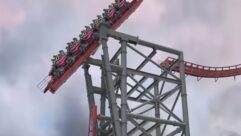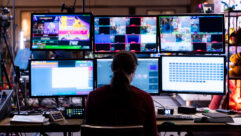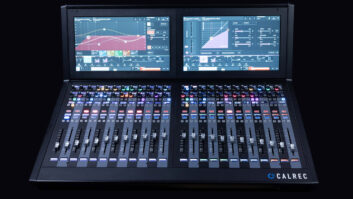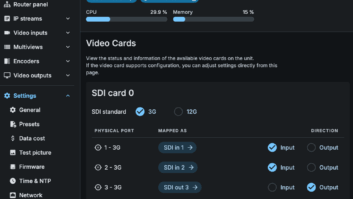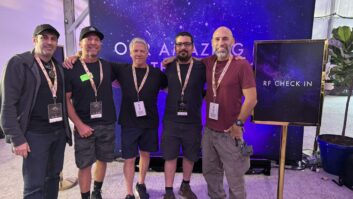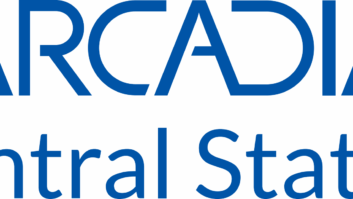
Native AV Installation at National Museum of the American Indian, Part 1
May 24, 2011 11:32 AM,
With Bennett Liles
Listen to the Podcasts
|
Editor’s note: For your convenience, this transcription of the podcast includes timestamps. If you are listening to the podcast and reading its accompanying transcription, you can use the timestamps to jump to any part of the audio podcast by simply dragging the slider on the podcast to the time indicated in the transcription.
When Electrosonic was called in for a project at the National Museum of the American Indian, they came up with an interesting mix of historical artifacts and 21st-century motion graphics and interactive displays to tell the story behind them. Project engineer Randy Sherwood is here to tell us how they tackled that job and made the system reliable and easy to operate. That’s coming up next on the SVC podcast.
Randy, thanks for being with me here on the SVC podcast from Electrosonic and we’re talking about that big installation you did at the National Museum of the American Indian, but first tell me a little bit about Electrosonic.
Electrosonic, we’re an AV systems integration company. We have offices in the US, Asia, and Europe. We’ve been in business for 47 years and we work on complex AV projects both large and small. We have three primary markets: corporate, control rooms, and entertainment and that includes theme parks and museums like the National Museum of the American Indian. [Timestamp: 1:21]
And of course Electrosonic is into a lot of different things. I see your company listed just about everywhere now but this one was unusual because of the unique way of blending the old with the new and using such an interesting way to do that. How did you first get involved with the project at the National Museum of the American Indian?
PPI Consulting chose us to work with them and once they meet with the client, then they find out what the client needs and all that stuff and then that’s handed over to our design team who does the initial design and then once they’re done it’s handed over to a engineering department and that’s where I get involved. So I was chosen to do the engineering for this project. [Timestamp: 1:59]
OK, and as I was saying this is such an interesting mix of real-world artifacts and high-tech video and sound. Did it pose any special situations doing this? I mean you’ve got this very old-world subject matter and you’re presenting it in a very 21st century way with video workstations and interactive displays. Did you have any sort of a cultural class with this combination?
Well the people who built all the displays worked with us in integrating the electronics into the displays, so it’s pretty seamless. But yeah, it was interesting trying to mix the electronics in with all these rare, really old artifacts so yeah, there were some challenges. [Timestamp: 2:39]
Yeah in terms of artifacts, what do they have in there? We know it’s a museum of the American Indian so that brings to mind all sorts of things like headdresses and tomahawks and arrowheads and things like that.
They do, they have absolutely all kinds of stuff in there and when you first walk in there’s a really big display of this giant Indian-like cape in this big flat display and it’s just…it’s amazing. [Timestamp: 3:01]
So how many exhibits did Electrosonic install? You put some linear video stations and interactive work stations in there?
Yes we did ten linear video stations and ten interactive stations and then two Dell regular computer workstations. [Timestamp: 3:16]
OK so you’ve got the actual Indian artifacts right there in front of you and what sort of content do you get on the workstations? And how and where is all that stored?
As you go through the gallery the exhibits are arranged by geographic region so the linear video stations, they have general information from that region and the interactive work stations, they have information specific to an artifact that’s right next to the work station and then more information that just builds on that. And the computer workstations allow access to the museum’s web site with additional information on the gallery. As far as where the content is stored, it’s stored in our equipment racks on SD cards and on hard drives. The linear video stations get their content from the Alcorn McBride Video Binloops and the interactive workstations are driven by dedicated Dell computers. [Timestamps: 4:09]
Well that’s fantastic, you have the real stuff right there in front of you and anything you find especially interesting you can just push a button on the work station and the information just jumps right out on the screen.
Yes.
And for media station of all this information, why did you choose the Alcorn McBride Binloop media players?
Well in this case they were specified by the consultant PBI Consulting, but Electrosonic—we have a great relationship with Alcorn McBride. Their product is excellent and especially their product support. They’re really available to help you out when you need it and their equipment has been proven to be really reliable just year after year. These units were also used in the National Museum of the American Indian in Washington D.C., so it was a natural fit for the client. They were already familiar with them. [Timestamp: 4:53]
1
Native AV Installation at National Museum of the American Indian, Part 1
May 24, 2011 11:32 AM,
With Bennett Liles
OK, so those are already pretty well tested and proven in an environment that’s pretty similar to the one you’re working in here.
Absolutely, yep.
Yeah I did a little reading on the Alcorn McBride Binloop media players and reliability really seems to be the name of the game with those.
Yes and they’re easy to program. They each have an SD card so it just makes the whole thing pretty easy. [Timestamp: 5:12]
You’ve got renovated but basically older architecture and with this of course there’s the visiting public and there’s always going to be some aesthetic considerations. You’ve got central storage and there have to be some substantial cable runs. So were there any issues as far as getting cabling run or places that you couldn’t go with it?
Yeah I don’t know if you’ve been to the Alexander Hamilton US Customs House but 80 percent of all customs stuff used to come through this building—it’s an amazing…just all this marble. It’s an amazing building but Peter Brill and his team at the museum did a great job in getting the facility ready for us. Working in an historic building like this, not designed for modern AV equipment, it often makes the cable runs longer because you have to run the cable wherever you can find some kind of unobtrusive path. We had to use different cable routes for each half of the gallery so even though some displays are only a few feet apart, the cable runs can differ by a hundred feet. But it was definitely a lot of work but the end product is very clean, so that’s what we were shooting for. [Timestamp: 6:13]
OK, now what kind of cabling and what format on the video signals are we talking about on this?
Its Cat-5 cable and the video signals are VGA. We used extenders to do that. [Timestamps: 6:23]
OK, well that sounds like it’s not a problematic thing on cost at all. I would think that’s a very economical way to go on cable.
Yes, the extenders can be costly depending on what you use, but yes, the cable was pretty inexpensive. [Timestamp: 6:35]
And fairly easy to work with in tight places. So we’re going analog on Cat-5 with the video and that’s not a real cutting edge thing—it’s pretty well proven. Tell me about the ELO 22in. touch screens in there.
Yes the interactive workstations, those have…each have an ELO so there’s ten of the ELO 22in. touchscreens and those were programmed by Potion Design in New York. [Timestamp: 6:57]
Now that’s interesting as far as the programming on those things. If you’ve got a museum already set up with these things I would think that would give you a good guide but you’ve got all kinds of people coming in there and it’s got to be at a good basic level where anybody can operate it. So was there any kind of extensive, say, testing of these stations with real people before you turned them loose on the public?
Yeah, absolutely. They developed it and we installed some stuff and worked on it and the screens are mounted in a portrait orientation and there’s actually a bar across the bottom of the screen that allows you to scroll through the different content. And once again, these are the displays that are right next to the actual object. So you scroll…you can scroll by swiping horizontally anywhere on the screen—just like an iPhone—then you can touch different pictures and the picture will zoom in and out and then other pictures actually start video content playing. [Timestamp: 7:48]
I would think, for the younger crowd in particular, all the motion graphics would be a real draw for that.
Yeah absolutely, it definitely adds to the galleria. [Timestamp: 7:55]
And in Part 2, we’re going to be getting into how all of this is centrally controlled and fed out to all the workstations. Randy, it’s been great having you here, thanks for stopping by.
2


